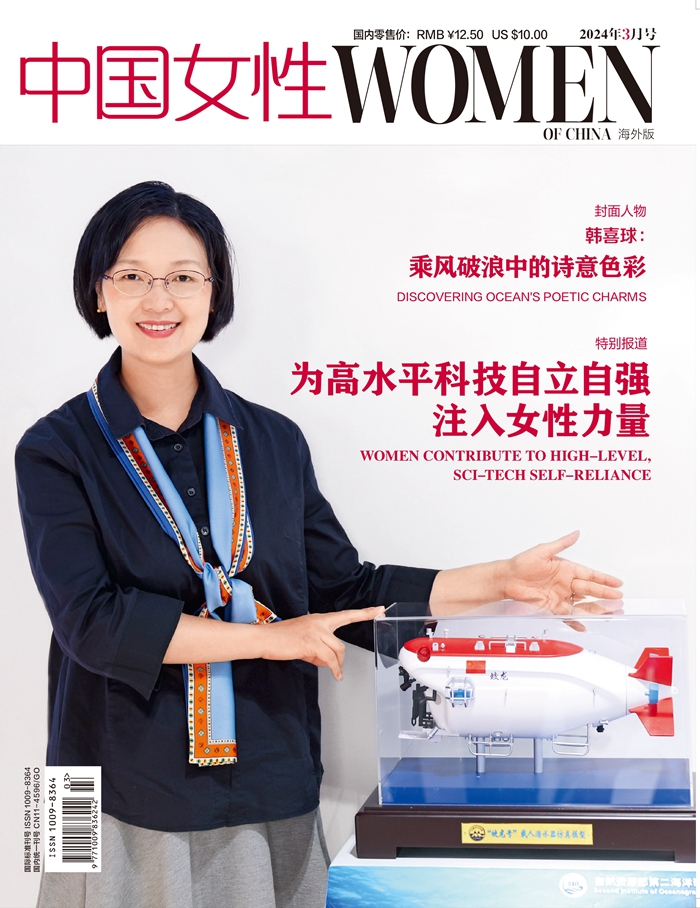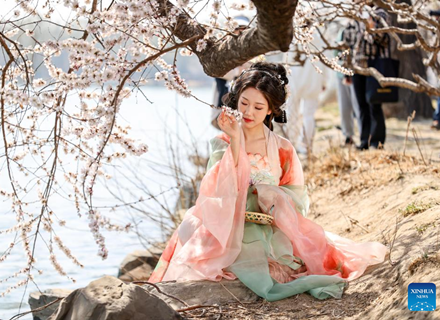A Surviving and Evolving Musical 'Aristocrat'

Konghou is a traditional, plucked Chinese musical instrument. During the past millennium, countless people, from around the world, have been fascinated by Konghou's dulcet, celestial sounds.
"Today millions of people play the guzheng (a Chinese plucked zither) in China, but the number of people learning konghou is less than 500," says Wu Qian, a foremost konghou master and virtuoso. Thus by contrast, konghou, a multi-stringed plucked instrument of the harp family, proves to be the one only for a selected few. However, Wu seems to be very satisfied with this figure. As konghou has always been primarily made and played for display and appreciation throughout history, it is not likely it will ever become a popular musical instrument any time in the future. For the vast majority of people, they learn about konghou by admiring, watching and listening to it, and deem it as one of the most crucial musical embodiments of Chinese culture. Nevertheless, they do not feel any desire to learn to play it.

A Royal Instrument
According to Wu, in antiquity, konghou was an instrument that was only played in the royal palace, as only royal members were entitled to savor its dulcet, celestial sounds. If so, it is very logical that the quantity of contemporary konghou performers would remain at a rather moderate number, and the future potential of konghou evolving into a popular instrument would be quite small, since that has been its fate for millennia.
Legends have it that the god of music was so amazed by the scenic beauty of the mortal world that he was reluctant to leave. When he finally had to depart, he left behind his beloved konghou as a token of his special fondness of that place. In ancient times, konghou was an instrument only played for royal members of the court in the palace. It was also employed as an instrument to facilitate intellectual development of princes and princesses. On the occasion when konghou was played for the emperor while he was conducting ceremonial worship of the heavens and earth, everyone except for members of the royal court must withdraw from the immediate area, because ordinary people were not allowed to hear the instrument played.

Rebirth
Since it appeared in the Shang Dynasty (1600-1046 BC), the development of konghou has been marked by frequent renewals, making it a living fossil of Chinese history.
Konghous made in ancient times had frets, but were not yet equipped with modulation devices, so its range of notes was relatively limited. The emergence of the two-row stringed konghou (also known as a double-course konghou) can be traced back to as early as the times when the Dunhuang murals were created. Moving forward in history, it reached its peak of popularity in the Qing Dynasty (1616-1911).
The design and music range of konghou have gone through a number of changes throughout its history, which helped it smoothly adapt to various times, local cultures, and aesthetics during different periods. People's preferences for music vary in different eras, consequently the modern and classical konghous differ in many ways. Konghou is a progressive instrument, always ready to integrate into the present era by reshaping itself. Wu points out that this trait of konghou corresponds very well to the spirit of Chinese literati, which is capable of surviving under all circumstances.

Chinese Harp? No
In the eyes of laymen, the Chinese konghou is quite akin to the Western harp in respects of shape, sound mechanism and playing techniques, and many people even think they are the same instrument. As a master of konghou as well as a professional harpist, Wu is most eligible to draw a comparison between these two instruments.
The biggest difference between konghou and harp lies in the number of rows of strings. Konghou has two rows of strings, Wu explains. This means that, when tuning the instrument, it requires that two accurate tunings be conducted at the same time by stepping on two tuning pedals. Besides, two sets of strings enable polyphony, making possible the creation of copious tones and notes simultaneously. Frets are a bonus to konghou's performance, allowing it to produce glides — a unique element in classical Chinese music. The hardness and tension of the strings on the two instruments, as well as the number of rows of strings, are different from each other, leading to different playing skills, including fingering techniques, finger controls, how to use force, and even use of knuckles.
For a long time, konghou was referred to as a Chinese harp in international competitions. Since 2001, following the unremitting efforts of Cui Junzhi, a promoter of modern konghou, who has been dedicated to disseminating the art of konghou for decades, konghou eventually stepped out upon the world stage under its own name.

Modern Evolvement
Wu, who learned to play the konghou under Cui Junzhi's tutelage, has won many global awards.
However, Wu is not engrossed with those glittering titles. "Art must never be labeled with the tag of any individual. We should promote art rather than individuals," she has been quoted as saying.
Now, Wu is putting great effort into including the art of playing the konghou in the world's cultural heritage list. She believes that Chinese people have cultural genes in their bones, and music is a vital part of culture. "This gene may be developed by musicians. Rewards or accomplishments are not individual credit, but a mission endowed to you by history, and you are chosen to excel at it," says Wu.
Every generation of konghou musicians have contributed their part to the evolvement of this unique traditional Chinese musical instrument. Wu says, "One person can inspire other people, but one person's efforts are limited." However, for thousands of years, there have been generations of konghou craftsmen and players, who have dedicated their lives and wealth to the passing down of konghou, thus enabling the constant progress of this instrument. This is not a personal achievement, but a cultural and historical accumulation.
Though it is a musical instrument that demands high skill, the number of konghou professional players keeps increasing in recent years. Hoping to bring the charm of konghou to more people, Wu has been committed to introducing konghou in modern ways by organizing saloons, concerts, and other social events. Considering that konghou concert goers are limited, Wu tries to convert a traditional concert into a concert of instrumental music drama, a musical genre highlighting each performer's ability to shift roles among actor, dancer, singer, and musical performer. This proves to be effective in demonstrating traditional Chinese art and enhancing audience engagement.
It is important for musicians to preserve the classical features of konghou performance when carrying out public communication and promotion of the instrument, while at the same time being inclusive. "The first step is to make the art of konghou accessible to people through modern means, and naturally audience's attention will be captivated by it," says Wu. Living in a palace as a privileged royal instrument, konghou has never gained popularity among the public, but it has been evolving all along, striving to keep up with the pace of the times in its own way.
Photos Supplied by VCG
(Source: China Today/Women of China English Monthly August 2022 issue)
Please understand that womenofchina.cn,a non-profit, information-communication website, cannot reach every writer before using articles and images. For copyright issues, please contact us by emailing: website@womenofchina.cn. The articles published and opinions expressed on this website represent the opinions of writers and are not necessarily shared by womenofchina.cn.








 WeChat
WeChat Weibo
Weibo 京公网安备 11010102004314号
京公网安备 11010102004314号